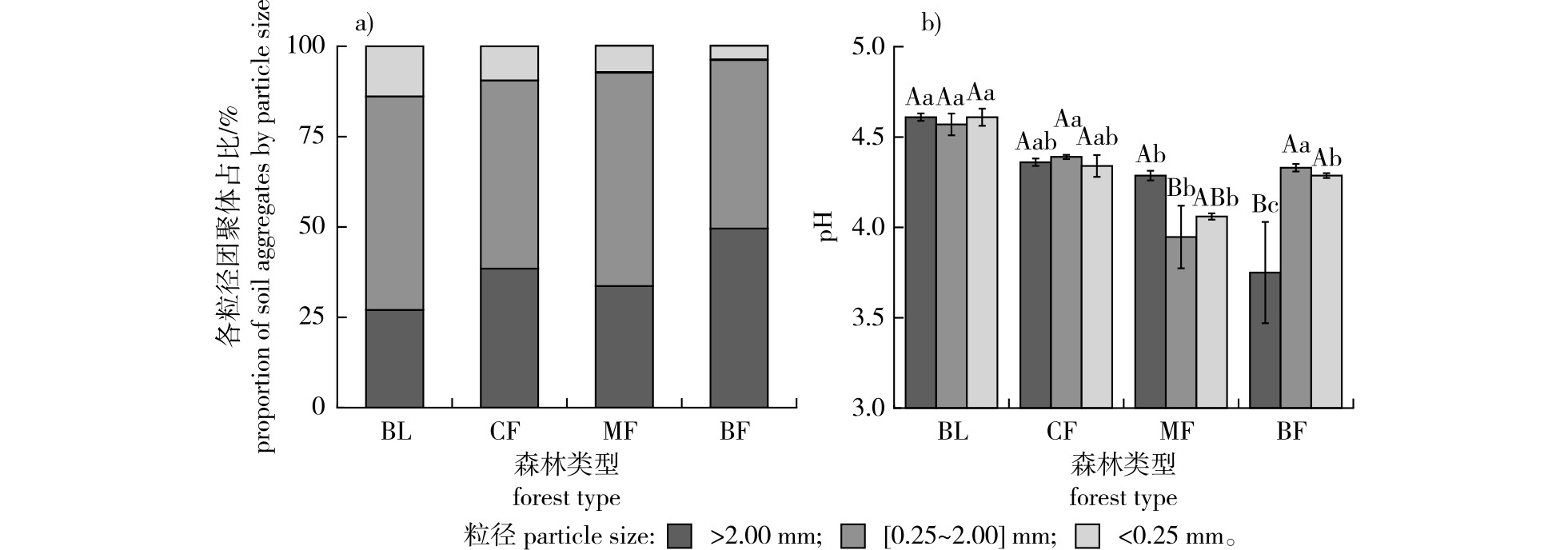 PDF(2435 KB)
PDF(2435 KB)


Investigation of soil aggregate characteristics and their impact on phosphorus cycling during forest type transitions
ZHOU Chuifan, ZHENG Yawei, QIAN Zhou, LIANG Jingjing, ZHOU Jiagui, DAI Wencai, YU Yuanchun
Journal of Nanjing Forestry University (Natural Sciences Edition) ›› 2025, Vol. 49 ›› Issue (5) : 65-74.
 PDF(2435 KB)
PDF(2435 KB)
 PDF(2435 KB)
PDF(2435 KB)
Investigation of soil aggregate characteristics and their impact on phosphorus cycling during forest type transitions
【Objective】This research aims to investigate the characteristics of phosphorus forms in soil aggregates, iron oxids and the distribution of phosphate-solubilising bacteria in different forest types, and to reveal the relationship between phosphorus forms and forest type transition, so as to provide a reference for the understanding of the influence mechanism of soil phosphorus cycling in vegetation restoration and the assessment of soil quality.【Method】Soil samples were collected from fixed plots of bare land (BL), coniferous forest (CF), mixed coniferous broad-leaved forest (MF), and broad-leaved forest (BF) at the National Positioned Observatory for Red Soil Hills Ecosystems in Changting County, Fujian Province, China, and analysed the composition of soil agglomerates of all grain sizes by the dry sieve method, and the phosphorus content [total phosphorus (TP), effective phosphorus (AP), inorganic graded phosphorus, and the content of iron oxides (Fed), amorphous iron (Feo), and complex iron (Fep)] of aggregates of all grain sizes, respectively, were measured by the dry sieve method, and combined with the high-throughout sequencing for the determination of the characteristics of phosphorus-solbuiling bacterial (PSB) community structure and composition.【Result】(1)Soil aggregates were classified by particle size into <0.25 mm (micro-aggregates), [0.25, 2.00] mm (small aggregates), and >2.00 mm (large aggregates). The proportions from low to high were: micro-aggregates, large aggregates, and small aggregates. small aggregates were dominant, with a proportion ranging from 40% to 53%.(2) During the transition of forest types, the inorganic phosphorus content in soil aggregates primarily existed as occluded phosphorus (O-P), which accounted for over half of the total inorganic phosphorus. Calcium phosphorus (Ca-P) displayed an initial increase followed by a decrease. Moreover, the content of aluminum phosphorus (Al-P) and iron phosphorus (Fe-P) rose with the decrease in particle size of soil aggregates. (3) Within the same particle size of soil aggregates, free iron oxide (Fed) contents generally decreased, while complexed iron oxide (Fep) contents generally increased. The content of amorphous iron oxide (Feo) in >2.00 mm aggregates generally increased, and in [0.25,2.00] mm and <0.25 mm aggregates, it first increased, then decreased, and increased again. (4) A reduction in soil aggregate particle size was associated with an overall increase in the richness of PSB (Chao1, observed_species) and a general decrease in PSB diversity (Shannon, Simpson) with the transformation of forest types. 【Conclusion】As vegetation transitions from bare land to broad-leaved forests, the concentrations of amorphous iron oxides and complex iron forms increase, facilitating the formation and maintance of larger soil aggregates. However, PSB preferentially inhabit microaggregates and small aggregates, highlighting the critical role that these smaller aggregates play in supplying effective phosphorus within mature forest ecosystems.

red soil erosion area / soil aggregate / inorganic phosphorus / iron oxides / phosphorus solubilizing bacteria
| [1] |
邓蕾, 刘玉林, 李继伟, 等. 植被恢复的土壤固碳效应:动态与驱动机制[J]. 水土保持学报 2023, 37(2):1-10.
|
| [2] |
高倩倩, 杨孜奕, 潘芳莹, 等. 生物炭施用下亚热带红壤铁还原及磷形态转化关系研究[J]. 林业科学研究 2023, 36(5):149-159.
|
| [3] |
肖胜生, 房焕英, 徐佳文, 等. 侵蚀区植被恢复过程中土壤有机碳稳定性的研究进展[J]. 水土保持学报 2022, 36(5):1-8.
|
| [4] |
|
| [5] |
周梦田, 刘莉, 付若仙, 等. 杉木木荷凋落物分解对杉木人工林土壤碳氮含量和酶活性影响[J]. 南京林业大学学报(自然科学版) 2024, 48(5):131-138.
|
| [6] |
|
| [7] |
马祥庆, 范少辉, 陈绍栓, 等. 杉木人工林连作生物生产力的研究[J]. 林业科学, 2003, 39(2):78-83.
|
| [8] |
|
| [9] |
|
| [10] |
|
| [11] |
苏浩浩, 黄桥明, 邓翠, 等. 退化马尾松林恢复过程中芒萁覆盖对土壤微生物生物量碳氮及其周转的影响[J]. 水土保持学报 2023, 37(3):336-344.
|
| [12] |
|
| [13] |
梁晶晶, 王淑真, 丘伟娟, 等. 红壤侵蚀区不同植被类型土壤磷垂直分布特征及影响因素研究[J]. 水土保持学报, 2023, 37(3):208-217.
|
| [14] |
鲁如坤, 土壤农业化学分析方法[M]. 北京: 中国农业科技出版社, 2000.
|
| [15] |
|
| [16] |
王淑真, 梁晶晶, 包明琢, 等. 不同林龄杉木林土壤磷形态与解磷菌变化[J]. 林业科学, 2022, 58(2):58-69.
|
| [17] |
张虹, 于姣妲, 李海洋, 等. 不同栽植代数杉木人工林土壤磷素特征研究[J]. 林业科学研究, 2021, 34(1):10-18.
|
| [18] |
|
| [19] |
|
| [20] |
|
| [21] |
王琼, 陈延华, 张乃于, 等. 长期施磷黑土中磷的吸附-解吸特征及其影响因素[J]. 植物营养与肥料学报, 2022, 28(9):1569-1581.
|
| [22] |
|
| [23] |
|
| [24] |
|
| [25] |
|
| [26] |
|
| [27] |
|
| [28] |
|
| [29] |
|
| [30] |
|
| [31] |
|
| [32] |
|
/
| 〈 |
|
〉 |